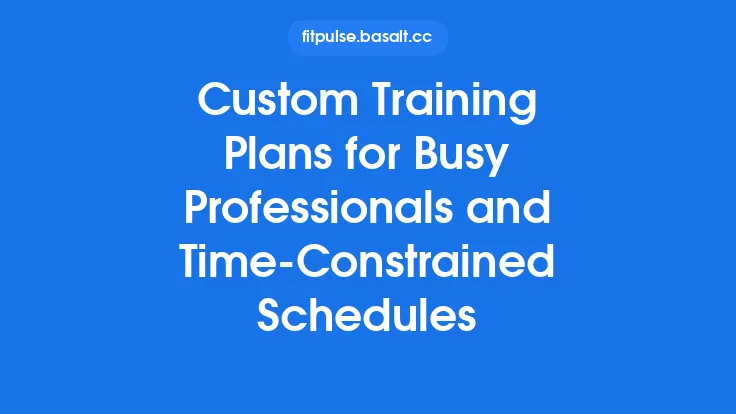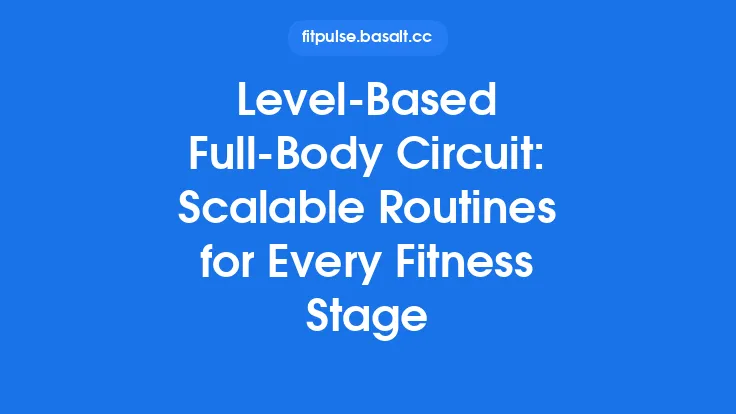A hectic schedule often leaves little room for a traditional workout, yet the physiological benefits of regular exercise are non‑negotiable for long‑term health, productivity, and stress management. High‑Intensity Interval Training (HIIT) offers a scientifically backed solution: short bursts of maximal effort followed by brief recovery periods, delivering cardiovascular, metabolic, and muscular gains in a fraction of the time required by steady‑state cardio or conventional strength sessions. By structuring a 10‑minute full‑body HIIT circuit that can be performed in a living room, bedroom, or office break‑room, busy professionals can reap these benefits without sacrificing meetings, deadlines, or family time.
Why HIIT Works for Professionals
- Time Efficiency – The entire session, including warm‑up and cool‑down, fits neatly into a coffee break or a quick transition between meetings.
- Metabolic Afterburn (EPOC) – The intense nature of the intervals elevates oxygen consumption post‑exercise, meaning calories continue to be burned for up to 24 hours after the session ends.
- Cardiovascular Health – Repeated spikes in heart rate improve VO₂ max and endothelial function, both linked to reduced risk of heart disease.
- Muscle Preservation – Unlike long, low‑intensity cardio, HIIT incorporates resistance‑type movements that stimulate muscle protein synthesis, helping to maintain lean mass during periods of high occupational stress.
- Neurocognitive Boost – Acute bouts of high‑intensity activity increase brain‑derived neurotrophic factor (BDNF), which supports focus, memory, and mood—critical assets for demanding work environments.
Designing a Balanced 10‑Minute Circuit
A well‑rounded circuit should address the major movement patterns: push, pull, hinge, squat, lunge, and core stabilization. By alternating between upper‑ and lower‑body movements, you allow localized muscle groups to recover while maintaining an elevated heart rate.
| Segment | Duration | Exercise | Primary Muscles |
|---|---|---|---|
| Warm‑up | 1 min | Dynamic mobility (arm circles, hip circles, leg swings) | Full‑body priming |
| Interval 1 | 40 s work / 20 s rest | Push‑Press (dumbbells or bodyweight) | Shoulders, triceps, quadriceps |
| Interval 2 | 40 s work / 20 s rest | Reverse Lunge to High Knee (alternating) | Glutes, hamstrings, hip flexors, core |
| Interval 3 | 40 s work / 20 s rest | Renegade Row (or plank‑row variation) | Upper back, biceps, core stabilizers |
| Interval 4 | 40 s work / 20 s rest | Single‑Leg Romanian Deadlift (bodyweight or light kettlebell) | Posterior chain, balance |
| Interval 5 | 40 s work / 20 s rest | Burpee‑to‑Mountain‑Climber Combo | Full‑body power, cardio |
| Cool‑down | 1 min | Static stretch (chest, hamstrings, hip flexors) | Recovery |
Total active work: 5 × 40 s = 200 s (≈ 3 min 20 s)
Total rest: 5 × 20 s = 100 s (≈ 1 min 40 s)
Warm‑up + cool‑down: 2 min → 10 minutes total.
The Core Moves Explained
1. Push‑Press
- Execution: Start with feet shoulder‑width apart, dumbbells at shoulder height. Dip slightly at the knees, then explosively extend the hips and press the weights overhead.
- Why it matters: Simultaneously trains the deltoids, triceps, and lower‑body power generators, delivering a true full‑body stimulus.
2. Reverse Lunge to High Knee
- Execution: Step back into a reverse lunge, drive through the front heel to return to standing, and immediately lift the opposite knee to chest height. Alternate sides.
- Why it matters: Engages the glutes and hamstrings while challenging balance and hip flexor activation—key for posture during prolonged sitting.
3. Renegade Row
- Execution: In a high plank, row one dumbbell toward the rib cage while stabilizing the core, then switch sides. If equipment is unavailable, perform a “plank‑to‑push‑up” row using bodyweight.
- Why it matters: Strengthens the scapular retractors and latissimus dorsi, counteracting forward‑rounded shoulders common in desk work.
4. Single‑Leg Romanian Deadlift
- Execution: From a standing position, hinge at the hips while lifting one leg straight behind, keeping the torso parallel to the floor. Return to start and repeat. Use a light kettlebell for added load if desired.
- Why it matters: Reinforces posterior chain strength and unilateral stability, reducing the risk of lower‑back discomfort.
5. Burpee‑to‑Mountain‑Climber Combo
- Execution: Perform a standard burpee (squat, plank, jump) but replace the jump with a rapid set of mountain climbers (alternating knees to chest) for 10‑15 seconds before standing.
- Why it matters: Maximizes cardiovascular demand while maintaining a full‑body muscular challenge, perfect for the final metabolic push.
Timing and Rest Intervals
The 40‑second work / 20‑second rest ratio (2:1) is a sweet spot for most professionals because:
- Physiological Load: It allows the phosphagen system to partially replenish, enabling high‑quality repetitions throughout the circuit.
- Cognitive Simplicity: A consistent timer eliminates decision fatigue—just start, finish, and move to the next exercise.
- Scalability: If you find the work interval too easy, increase to 45 s work / 15 s rest; if overly taxing, reduce to 30 s work / 30 s rest.
Use a simple interval app, a kitchen timer, or a smartwatch with customizable HIIT presets to keep the cadence precise.
Scaling Up or Down
| Goal | Modification |
|---|---|
| Increase Intensity | Add external load (dumbbells, kettlebells, resistance bands). Use a weighted vest for total‑body overload. |
| Decrease Impact | Replace burpee jumps with step‑back burpees; perform reverse lunges without the high‑knee component. |
| Focus on Strength | Extend work periods to 45 s and shorten rest to 15 s, emphasizing slower, controlled repetitions. |
| Emphasize Cardio | Shorten rest to 10 s and increase movement speed, especially on the mountain‑climber segment. |
Progression should be systematic: once you can complete the circuit with perfect form for three consecutive sessions, introduce a modest load or adjust the interval ratio.
Equipment Options and Alternatives
| Exercise | Primary Equipment | Low‑Cost Alternative |
|---|---|---|
| Push‑Press | Dumbbells or kettlebells | Backpack filled with books |
| Renegade Row | Dumbbells | Two water bottles (≈ 500 ml each) |
| Single‑Leg RDL | Kettlebell or dumbbell | Soup can or a small sandbag |
| Burpee‑to‑Mountain‑Climber | None | No change needed |
The key is to maintain a stable center of gravity and controlled resistance; improvisation works as long as the load is symmetrical and the movement pattern is preserved.
Safety and Form Checklist
- Warm‑up – Never skip the dynamic mobility segment; it primes joints and reduces injury risk.
- Neutral Spine – Keep the lumbar region in a neutral position during hinges and rows; avoid excessive rounding.
- Joint Alignment – Knees should track over the second toe during lunges; elbows stay close to the body during rows.
- Breathing – Exhale on exertion (press, row, lift) and inhale during the recovery phase of each rep.
- Progressive Overload – Increase load or speed only after mastering technique at the current level.
- Environment – Ensure a non‑slippery surface, adequate ceiling height for overhead presses, and enough space to move safely.
If you experience sharp pain, dizziness, or excessive shortness of breath, stop immediately and consult a healthcare professional.
Tracking Progress and Staying Motivated
- Objective Metrics: Record total repetitions per interval, perceived exertion (RPE 1‑10), and heart‑rate zones (if a monitor is available).
- Subjective Metrics: Note energy levels, mood, and productivity changes throughout the workday. Many professionals report a “post‑HIIT clarity” that translates into better focus.
- Goal Setting: Use SMART goals (Specific, Measurable, Achievable, Relevant, Time‑bound). Example: “Increase total reps in the push‑press interval from 20 to 30 within four weeks.”
- Accountability: Pair with a colleague for a virtual “HIIT break” via video call, or log sessions in a shared spreadsheet.
Consistent logging not only provides data for future program tweaks but also reinforces the habit loop—cue (calendar reminder), routine (10‑minute circuit), reward (immediate energy boost).
Integrating the Circuit into a Busy Day
- Morning Kick‑Start – Perform the circuit immediately after waking to activate metabolism and set a productive tone.
- Mid‑Afternoon Reset – Use a 10‑minute break between meetings to combat the post‑lunch slump.
- Pre‑Evening Transition – Finish the workday with the circuit to decompress and signal the shift from “office mode” to “home mode.”
Pair the session with a brief hydration habit (a glass of water before and after) to support performance and recovery.
Common FAQs
Q: Can I do this circuit every day?
A: Yes, provided you vary intensity and listen to your body. Alternating a “hard” day (full load) with a “recovery” day (bodyweight only) helps prevent overuse injuries.
Q: Do I need a heart‑rate monitor?
A: Not mandatory, but it offers valuable feedback on cardiovascular strain. If unavailable, use the talk test: you should be able to speak only in short phrases during work intervals.
Q: How does this differ from a Tabata protocol?
A: Tabata follows a strict 20 s on / 10 s off pattern for eight rounds, focusing heavily on anaerobic capacity. The 40 s/20 s structure used here balances strength and cardio, making it more suitable for a full‑body circuit that includes complex movements.
Q: Will this replace traditional strength training?
A: It complements but does not fully replace dedicated strength sessions. For maximal hypertrophy, incorporate longer, heavier lifts 2‑3 times per week in addition to the HIIT circuit.
Q: What if I have limited space?
A: All movements can be performed within a 2 × 2 meter area. If ceiling height is an issue, replace the overhead press with a floor‑press variation using dumbbells.
By adhering to the principles outlined above—efficient interval timing, balanced movement selection, progressive overload, and diligent form monitoring—busy professionals can embed a scientifically sound, 10‑minute full‑body HIIT circuit into their daily routine. The result is a sustainable habit that bolsters cardiovascular health, preserves muscle mass, and fuels mental sharpness, all without compromising the demands of a high‑pressure career.





